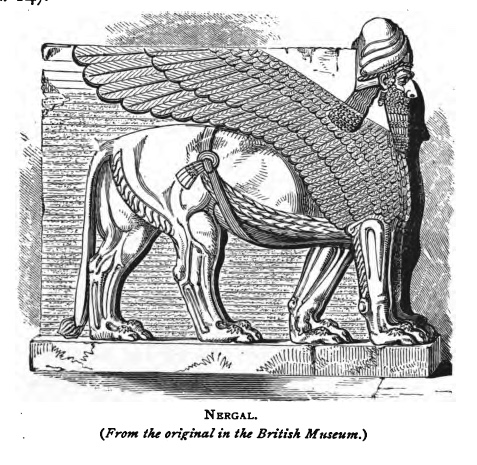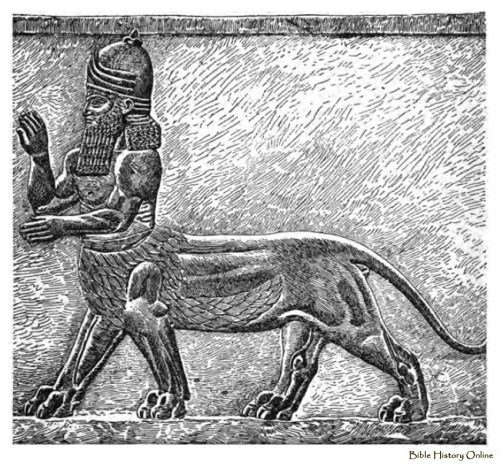Nergal, God of Death
“It was as the death-dealing lord of Hades that Nergal first became “the hero of the gods,” “who marches in their front.” The metaphor was taken from the champion who, like Goliath, places himself before his comrades and challenges the enemy to combat.
It is thus that we read in the story of the Deluge, when the flood of rain and destruction is described as coming upon the guilty world: “Rimmon in the midst of (heaven) thundered, and Nebo and the Wind-god went in front; the throne-bearers went over mountain and plain; Nergal the mighty removes the wicked; Adar goes in front and casteth down.”
As lord of Hades, too, he was made the son of Mul-lil. A hymn (K 5268), the colophon of which tells us that it was composed in Cutha, begins with the words: “Let Nergal be glorified, the hero of the gods, who cometh forth as the strong one, the son of Mul-lil.”
In the same hymn, Marad is declared to be his city, from which we may infer that Marad was near Cutha. Its protecting divinity, however, was, strictly speaking, Lugal-túda,”the royal offspring,” or perhaps “valiant king,” a personification of the thunder-cloud and lightning; but it is evident from the hymn that he had been identified with the death-dealing god of Cutha.
Of Laz, the wife of Nergal, we know little or nothing. Her name survived as the local divinity of Cutha, but her office and attributes were taken by Allat. Even Nergal himself as the lord of Hades belongs rather to the Accadian than to the Semitic period.
Among the Semites he was the hero and champion of the gods, and as such the destroyer of the wicked, rather than the king of death who slays alike the wicked and the good. The sovereignty of Hades had passed out of his hands, and he had become the companion of the solar Adar and the warrior of the gods of heaven.
Under his old name of Ner, however, a curious reminiscence of his primitive character lasted down to late times. In the hymns and other poetical effusions, we not unfrequently come across the phrase, ”mankind, the cattle of the god Ner.”
I have already drawn attention to the agricultural nature of early Chaldean civilisation, and the influence that agriculture had upon the modes of thought and expression of the population. Not only was the sky regarded as the counterpart of the Babylonian plain, and the heavenly bodies transformed into the herds and flocks that fed there, but the human inhabitants of the earth were themselves likened to the cattle they pastured and fed.
One of the earliest titles of the Babylonian kings was “shepherd,” reminding us of the Homeric ποιμην λαων, “shepherd of nations;” and in the Epic of Gisdhubar the sovereign city of Erech is termed the śubur, or “shepherd’s hut.”
Just as the subjects of the king, therefore, were looked upon as the sheep whom their ruler shepherded, so too mankind in general were regarded as the cattle slain by the god of death. They were, in fact, his herd, whom he fed and slaughtered in sacrifice to the gods.”
A.H. Sayce, Lectures on the Origin and Growth of Religion as Illustrated by the Religion of the Ancient Babylonians, 5th ed., London, 1898, pp. 196-8.


